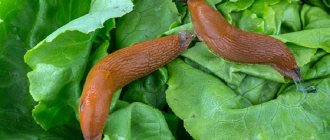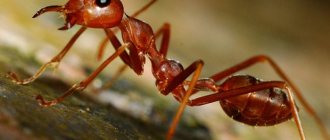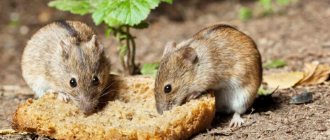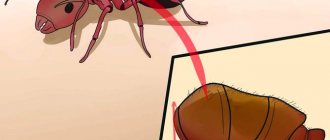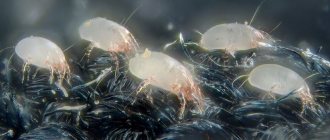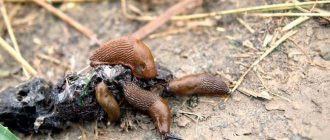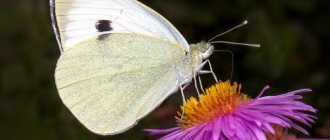Steps
1 Set up a habitat for your pet
- 1 Find a suitable container.
Slugs usually live well in regular aquariums. The aquarium should be approximately 20 by 20 centimeters (no less). You can buy it at a pet store or order it online.- Be sure to provide ventilation for the aquarium in advance. The lid must have holes for ventilation. For example, something like a fine mesh would work great.
- Slugs are very small, especially compared to reptiles, which are also usually kept in aquariums. Carefully inspect the vents to make sure that the slug will not escape through them.
- 2 Add filler to the aquarium.
The best filler is regular soil, grass, leaves, and the like. If you find a slug on the street, it is best to take soil, leaves and grass from the exact area where you found the animal. Be sure to sift the soil before adding it to the aquarium so that no objects dangerous to the slug get there along with the soil.- Once a week, remove the slug from the aquarium, transfer it to another container (also with holes!) Remove the old filler and replace it with new one.
- 3 Buy various items for the aquarium.
Slugs will really enjoy items such as various artificial plants and leaves. In addition, do not forget to bring real leaves, twigs and other objects from the street that a slug can climb on.- If you bring something from outside, be sure to carefully inspect the item before placing it in the aquarium.
- 4 Clean your aquarium regularly.
Once every three months, do a general cleaning of the aquarium: wash all the walls and bottom of the aquarium and replace the filler. Rinse twigs and other items in the aquarium with water, then allow them to air dry. If the sprigs immediately become soggy and soft due to water, replace them with new sprigs.- Slugs are very sensitive to chemicals. Therefore, do not wash your aquarium with soap! Wash the aquarium and items in it only with warm water.
- Slugs are very sensitive to regular tap water, so you should choose distilled water for them.
2 What to feed a slug
- 1 Wash vegetables and fruits.
Slugs love plants. For example, you can give the slug leftover fruits and vegetables from your table. You can give him fresh fruits and vegetables, but first wash them in distilled water. Before you feed the slug, it is important to remove traces of pesticides from the fruit.- If possible, choose fresh fruits that are grown without the use of pesticides.
- In fact, slugs like vegetables more than fruits. They can die from too much sugar, even if it's natural sugar from fruit.
- 2 Include leaves and plants in your slugs' diet.
Place plants that you find outside in the slug's aquarium. Additionally, slugs feed on decaying plants, so if you have a dying plant in your home, you can feed it to the slug. - 3 Clean up leftover food every day.
Slugs may not eat all the food you bring them. Leftover food (especially fruit) attracts fruit flies. Fruit flies can harm your slug, so you should clean up and discard any leftover food from your slug's tank every evening. This way, you will reduce the risk that your pet's safety will be compromised. - 4 Do not use dishes, but a spray bottle.
Slugs do not require a separate bowl of water, they just need a moist environment. Therefore, spray water into the aquarium every day from a spray bottle. It's best to use filtered or distilled water because regular tap water can be dangerous to slugs. Humidity is very important because slugs absorb moisture from the air.
3 How to avoid common mistakes
- 1 Never use any sprays near a tank containing a slug.
As mentioned above, slugs are very sensitive to chemicals because they absorb everything in the air through their skin. Therefore, never use hairsprays or other aerosols in the same room as the slug aquarium. This could kill your pet! - 2 Do not pick up the slug.
The slug should not be constantly removed from the aquarium. Only move him to another tank or container if you need to clean his tank. Slugs don't like to be handled, and chemicals on your hands (like leftover soap or hand lotion) are harmful to slugs. - 3 Don't forget to spray the water in the aquarium every day!
Slugs require a moist environment to live. Spray some distilled water into your slug's tank every day. The slug may die if the environment is not humid enough.- It is very important to use distilled water. Chemicals found in tap water can kill slugs.
- Slugs love shady areas, so do not place your slug aquarium in direct sunlight. Be sure to put something in the aquarium that will provide the slug with shelter (for example, a piece of bark)
- You can put vegetable and fruit trimmings into the aquarium, but only if you are sure that they do not contain pesticides!
Preventing shellfish invasion
We decided to tell you not only about how to destroy slugs on your site, but also about the prevention of pests that can simply be prevented from reaching young and fragile plants. You just need to adhere to the measures that we recommend, and you will not only be able to fight slugs in the garden and garden plots, but also improve your entire dacha with our advice:
- Firstly, the dacha must be clean and well-groomed. A minimum number of weeds will create good warming and ventilation of the soil, and will not provide places where coolness and humidity will stagnate. But this is a favorite place for slugs - humid, average temperature, shade, minimum disturbance. The same can be said about leaves in the garden, which should not just lie in heaps. It is there that moisture collects, and inside such an embankment it is quite cool;
- Secondly, it is important to keep pests away from food sources. To avoid collecting slugs in cucumbers and beds with young cabbage, try to protect them with a “sharp” barrier. This could be old plastic panels dug into the ground and sticking out only 3-5 cm, thin sheet metal or tin that creates the same fence, or even a scattering of nut shells through which a slug simply cannot climb;
- And thirdly, we recommend that you study methods of mulching beds and use small sawdust as mulch. Slugs prefer to avoid such places, since they simply cannot move through them for a long time. Sawdust sticks to the sticky body in the mucus, and the pest becomes practically helpless. Fine dry sand and sprinkling with wood ash also work well in a similar way.
Some preventive methods are very simple and can be used against slugs without wasting time or money. Agree, this is much better and more correct than then buying poisons and using them to poison not only pests, but also soil and crops.
What you will need
- Aquarium
- Vegetables and fruits
- Spray bottle
- Distilled or filtered water
- The soil
Slugs are terrestrial gastropods with a reduced shell or no shell at all. Slugs include all representatives of the families Onchidiacea and Soleolifera and some species from the family Sigmurethra. There are several hundred species of these animals in the world, their relatives are snails, as well as nudibranchs, which are sometimes called sea slugs.
Long banana slug (Ariolimax dolichophallus).
Anatomically, slugs are very similar to snails: their body actually consists of one large foot-foot fused to the head. On the upper side of the body behind the head, a mantle is visible - a kind of plate that hides the genitals and anus of the mollusk. Some species (they are called half-slugs) also have a tiny shell, but it is not visible from the outside because it is covered by a mantle. In general, slugs are characterized by bilateral symmetry, which is broken only by the unpaired pulmonary opening, which is always located on the right.
On the head of a banana slug there are two pairs of thin movable “horns”: one of them is used for smell, and the second has tiny eyes.
The size of most of these mollusks measures a few centimeters, but large species (banana slug, large roadside slug, blue-black slug) can reach a length of 15-30 cm! These animals are colored mostly in nondescript shades of brown, but the forest slug, for example, is anthracite-black, the red roadside slug is chestnut or orange-red, and the long banana slug is bright yellow.
The red triangle slug (Triboniophorus graeffei) from Australia is one of the most brightly colored species.
Slugs are found everywhere, but they reach the greatest species diversity and abundance in areas with a temperate and humid climate: the forest zone of North America, Western and Central Europe, and the rainforests of Australia and New Zealand. In these areas, slugs inhabit forests, fields, gardens, and meadows. Very unusual is the narrow endemic troglolestes Sokolov, which is found only in the caves of the Caucasus. This pattern of distribution of these mollusks is explained by the absence of a shell, which could serve as shelter from cold, heat and drought. Delicate slugs are forced to hide from the direct rays of the sun, so they are active mainly at night, in the evening and in the morning, and during the day they hide in thick grass and under leaves. Due to this exposure, slugs are forced to overwinter in the depths of the soil, with some species overwintering as adults, while others overwinter as eggs.
The world's largest blue-black slug (Limax cinereoniger) reaches a length of 30 cm.
These animals move due to wave-like contraction of the sole. Since the delicate body is subject to friction against a hard substrate, mollusks secrete mucus as a lubricant. Interestingly, it comes in two types: the watery one spreads from the center of the leg to its edges, and the thicker and stickier one stretches from the head to the tail. In some species the mucus is almost transparent, in others it is whitish, and a long visible trail remains behind the crawling mollusk. Both types of mucus are hygroscopic and can hold water, so the mucus not only facilitates movement, but also protects the defenseless mollusk from drying out. This substance has other uses. The mucus of some species is unpleasant to the taste and protects the mollusks from being eaten by predators. In a number of species it is so thick that its owner is able to move along vertical surfaces or upside down, and even hang on it as if on a thread. Despite the extremely low speed of movement, slugs sometimes make relatively long migrations - in search of food they can crawl over a distance of several hundred meters.
The red roadside slug (Arion rufus), like its fellows, due to strong muscle contraction, is capable of changing its body shape from an elongated worm-like to a compact, almost round one.
Among slugs there are species with all types of nutrition. Most of these mollusks are herbivorous. They are not particularly picky and gnaw leaves, above-ground parts of root crops, flowers and fruits. Some specialize in feeding on mushrooms, others are detritivores, that is, they eat dead parts of living organisms (fallen leaves, carrion, moss, lichens, feces). Finally, among slugs there are omnivorous and predatory species. Predatory mollusks catch earthworms, their smaller relatives; there are cases when they even attacked small chicks and mice. Slugs absorb food using a so-called grater (radula). It is a disc-shaped tongue dotted with thousands of small teeth. The mollusk methodically peels off the soft tissue layer by layer and becomes saturated.
Forest slug (Arion ater) feasts on red fly agaric (Amanita muscaria).
These animals breed once a year. Like all molluscs, slugs are hermaphrodites: each individual has female and male reproductive organs, but the reproductive products do not mature at the same time. First, sperm matures, packaged in special bags called spermatophores. During this period, the slug begins to secrete mucus with pheromones, by the smell of which it is found by the same relative.
During the mating ceremony, large roadside or leopard slugs (Limax maximus) are suspended upside down by slimy threads and their bodies are woven into a braid. Their blue penises curl into a ball.
People associate the word “slug” with a weak and worthless creature. In fact, among animals, slugs are a kind of “sexual giants”, since they have the largest penis relative to their body size. Its length is equal to or exceeds the length of the body; the absolute record holder is the long banana slug. His genitals reach 81 cm, with a body length of only 15 cm! The mating process itself is also unusual. When they meet, the mollusks are intertwined with their genitals, and given their great length, it is not easy to untangle this tangle. Therefore, after mating, many slugs simply bite off the partner’s genitals or their own. Over time, lost body parts grow back. After mating, the maturation of the eggs in the slug’s body ends, fertilization occurs, and the adult lays eggs in the ground. On average, each mollusk lays 30-70 large white or transparent eggs. Their development lasts 3-5 weeks. The eggs hatch into fully formed tiny slugs. They grow quickly and reach sexual maturity after 2 months. The life expectancy of these animals does not exceed 1-2 years.
Due to the absence of a shell, slugs are easy and desirable prey for many animals. They are eaten by raccoons, roaches, wild boars, ducks, chickens, hedgehogs, storks, waders, pheasants, starlings, pigeons, jackdaws, magpies, toads, frogs, and salamanders. Only dull coloring and low mobility protect against slug attacks. Minor damage and bitten off “horns” of mollusks are easily restored. In some areas, slugs are eaten raw or cooked, but raw slugs can carry helminths and meningitis pathogens.
Slug clutch.
In nature, slugs are of great benefit by destroying fallen leaves and turning them into humus, but there are also pests among them. Agricultural crops are primarily threatened by field slugs and netted slugs. These species damage strawberries, cucumbers, beets, turnips, lettuce, dill, zucchini, pumpkin, watermelons, melons, and wheat. Slugs not only gnaw on the fruits and sprouts of these plants, but also spread dangerous viral, bacterial, and fungal diseases of agricultural crops. Crawling through the grass, they can cause helminth infection in goats, sheep and chickens.
Slugs and snails are close relatives, only the former completely or, less often, partially lack a shell. They move by contracting the entire body, which acts as a sole and a leg at the same time. Hence the scientific name - gastropods. Distributed everywhere, here are just some types of slugs:
Sea slugs are found in the water. Only here we are not talking about a relative of the snail, but about an unusual fish. She has adapted to a deep-sea existence that was previously considered impossible by scientists. In the photo, the sea slug looks more like an overgrown tadpole. This form is most suitable for living at an unimaginable depth (almost 8 thousand meters). Some sea slugs live near the shores, without shelter under the huge thickness of water. This phrase is also popularly used to refer to nudibranchs, the closest relatives of gastropods.
The colors of the animals are varied. In addition to the usual gray or black ones, you may encounter purple slugs, white, yellow, green slugs, blue individuals and even red mollusks. This largely depends on the habitat. Surprisingly, some species make interesting pets. They are kept in special terrariums, the bedding at the bottom of which must be mulched so that the pets can move freely without the risk of damaging their delicate body-sole. These include the Madagascar slug. It is flatter and smoother than the garden species we are accustomed to, and looks like a fat, voracious worm covered in mucus.
Slug: what the insect looks like and whether it is necessary to fight it
The slug belongs to the order of gastropods. During development, the representative lost its shell. A slug is very similar to a regular snail. The only difference is the absence of a shell.
Neither the living organism itself nor its mucus poses any danger to humans. The mollusk is a garden pest. The creature eats fresh leaves and is capable of completely destroying crops. The slug must be destroyed as soon as possible.
The struggle is complex and may not produce a positive result for a long time.
There are many types of slugs
What does the creature look like?
The body of each slug consists of 3 sections:
Today we decided to share with you the most effective ways to kill slugs in your garden. Here you will find only the most effective methods, as well as several life hacks from experienced summer residents.
What kind of slugs are there, photo
Slugs are gastropods, land mollusks.
There are several varieties of these pests:
- Slugs are oblong mollusks without a shell. Most often they have a grayish-yellow or earthy color. They are the ones who most often attack vegetable gardens and orchards.
- Half-slugs are recognized by their rudimentary shell.
- Snails are horned slugs with a shell. There are many varieties of snails: forest snail, variegated garden snail, common hairy snail, bush snail, and grape snail. They all differ in the color of the body and the shape and coloring of the shell.
Mollusks live for several years: snails - 3-4 years, slugs - 1-2 years. They become most active in the second half of summer. Parasites actively reproduce, laying eggs in dark and damp places. Most often, clutches, and even the slugs themselves, can be found under stones, old stumps, in compost, garbage and manure heaps, under old tree bark, etc.
Slugs and snails are mostly nocturnal and hide in secluded places during the day.
Are there any benefits to slugs in the garden?
Oddly enough, but slugs are needed in the garden. They are an important link in the garden ecosystem. They themselves eat (in addition to cultivated plants) rotting parts and weed seeds. At the same time, slugs themselves are food for small rodents, lizards, and hedgehogs.
Therefore, the best option is to limit the number of mollusks in your area, but not completely eliminate them. Unfortunately, it is not always possible to do this.
What harm do they do?
Slugs feed on plant leaves. Moreover, they give the greatest preference to cultivated plants. Using their mouthparts, they devour soft tissue and gnaw holes in leaves, leaving mucus.
IMPORTANT! Moving from plant to plant, mollusks not only eat plant tissue, but also spread infection.
Mollusks feed on seeds, flower corms, berries (they especially like strawberries), cabbage and other vegetables. They do not disdain flowers and fruits if they can get to them. This is not to mention the leaves and stems of plants mentioned above.
Why do slugs and snails appear in the garden?
As mentioned above, slugs and snails are an important part of the ecosystem. In search of food and favorable conditions for growth and reproduction, slugs migrate between areas. If yours suits them, then they stay on it.
What does it mean? Slugs love moisture and warmth, and they also need shelter from the sun. If your site is waterlogged, there are many shady damp areas, boards are scattered, and stumps have not been removed, then with a high degree of probability you will encounter an invasion of slugs in the second half of summer.
Pests can also enter the garden along with infected vegetables, cuttings, seedlings, etc.
How to get rid of slugs using traditional methods
Unlike most insect pests, which are often only controlled by chemical insecticides, slugs can be controlled using traditional methods. The point here is that gastropods move only on the ground. Therefore, there are many ways to protect plants from them using simple traps and unique “barricades”.
REFERENCE. Most traditional methods take advantage of the main weakness of slugs - their soft and very sensitive body, which easily gets burned from contact even with not the strongest reagent.
How to use slaked lime
When shellfish invade your area, protect your plantings with slaked lime traps. Dilute it in water and pour a small stream into the improvised channels around the perimeter of the beds. This should be done after sunset, when the slugs become active. The mollusk crawls onto this “path” of lime and gets a chemical burn.
Pepper infusion against slugs
Use dried chilies or just buy ground pepper from the store. Pour 50 grams of the substance into a liter of cold water, leave for 2 days, then boil and leave again for two days. The resulting working solution is sprayed onto the plants before flowering.
Mustard powder for slugs
An infusion is made from mustard powder, which is sprayed on plants and watered on the ground around them. Mix 200 ml of water with a spoon of mustard, leave for an hour and add to 10 liters of water.
How to make bait traps
The next method is making bait traps. Place grated carrots, a piece of beetroot or leaves on the ground in a shady place. Cover the top with a rotten board or similar covering.
Periodically collect and destroy shellfish that have accumulated on your trap.
Wormwood infusion
This recipe will help not to destroy slugs, but to scare them away from plants. The fact is that mollusks cannot stand the smell of wormwood.
The tincture is prepared as follows.
Pick the wormwood and chop it finely with a knife. Then add water at the rate of 1 part wormwood to 5 parts water. Leave the mixture to ferment, stirring every day. In a month the infusion will be ready. Spray plants with it to protect against slugs.
IMPORTANT! Since the product is infused for 4 weeks, take care to prepare it in advance.
Catching slugs by hand
If there are not very many pests, then it makes sense to collect them manually. And then either destroy it or take it off site. But remember that it is better to wear gloves when collecting shellfish, as they leave sticky mucus on your hands.
Mulch for pests
Mulch as a remedy for slugs has been known since the 60s of the last century. Mulch plantings and row spacing, and then mollusks will not be able to get to your plants. Remember, the less smooth the surface, the harder it will be for slugs.
Does beer help with slugs?
You can fight shellfish using beer traps. You will need several half-liter plastic cups or plastic bottles cut in half and beer.
Containers are dug in around the perimeter of the beds or some individual vegetables. You can bury the cups flush with the ground or just above the soil level. Then beer is poured into the container. The smell and taste of the drink attracts slugs.
They crawl into glasses and drown in them.
How to use baking soda
Baking soda can be used in two ways. The first is to sprinkle it on the pests in the discovered lair. This will cause instant death of the entire population. You can also prepare a solution for spraying: 5 liters of water, 50 grams of soda, 10 ml of liquid soap or shower gel.
Vinegar as a means of control
Vinegar is used in the same way. 65 ml of 9% vinegar is diluted in 10 liters of water and sprayed with a solution of slugs.
Are they afraid of ammonia?
Ammonia helps in the fight against harmful shellfish. 2 tablespoons of liquid are diluted in 5 liters of water and the plants are sprayed. The smell of ammonia is unbearable for gastropods, and they do not attack plants.
What medications are there for slugs and snails, table
Special chemical preparations for slugs are called molluscicides. You can find out which of them are most effective in the fight against gastropods from the table below.
| Means | Method of preparation and use |
| Mesurol | Scatter the granules over the beds of plants most affected by slugs. Keep away from children and animals. Work strictly with gloves |
| Nemaslug | Spray the plants and water the soil around them. Treat 2-3 times at intervals of 1-2 weeks |
| Unichem | The gel is applied around plants (effective for large bushes) or along the perimeter of the beds. Creates a coating that slugs cannot overcome |
| BROS | Spread the granules over the entire area at the rate of 80 grams per 10 sq. m. Use in the afternoon. Take care of plants |
| Groza-3 | Sprinkle the powder on the area at the rate of 30 grams per 10 square meters in places where shellfish accumulate or appear most frequently. |
| Slug eater | Sprinkle the powder on the site at the rate of 30 grams per 10 square meters in places where shellfish accumulate or appear most frequently, as well as along the beds and between the rows. |
| StopUlit | Place baits in front of the plants. Apply as needed |
| NEUDORFF Ferramol | 500 grams per hundred square meters. Sprinkle later in the evening. Apply no more than 4 times per season |
| Predator | Place the bait on the substrate. 1 package per 70 sq. m., at least 4 traps per 10 sq. m. |
| Ulicide | 500 grams per hundred square meters. Sprinkle later in the evening. Apply once per season |
| Meta | Sprinkle the powder on the site in places where shellfish accumulate or appear most frequently, as well as along the beds and between the rows. |
Plants that repel pests
In order not to have to worry about preparing preparations for slugs and not to set traps, you can plant plants around the area whose smell repels pests.
These include onions and garlic, mustard, marjoram, wormwood, thyme, savory and some others. Plan the planting of these plants so that slugs do not have access to vegetable and berry crops.
Thyme
Mechanical methods of struggle
How to get rid of ants in the garden, in the greenhouse, in the house
Mechanical methods of combating slugs and snails mean creating protective barriers that are insurmountable for mollusks.
You can block the path of slugs to your vegetables and berries by sprinkling the paths with a mixture of sawdust with ash, bark, and pine litter. Egg shells, coarse sand, etc. are also effective.
You can also bury coffee grounds under plants. The result will be both a death trap for shellfish and a nutritious food for plants.
Another rather expensive way to protect yourself from invasion is to lay covering material with a copper coating around the perimeter of the plot or beds, which generates a low-voltage current. However, even weak electricity causes significant damage to the mollusks, and they begin to avoid the area.
Prevention measures
As we said above, with rare exceptions, slugs do not attack well-groomed areas. The most important measure to prevent the appearance of these pests is to keep your garden, garden or summer cottage clean and tidy.
- Remove weeds, even if they are located at the edge of your garden.
- Loosen the soil more often. Try to ensure that it has a uniform structure.
- Attract birds to your garden. But not too hard, otherwise you’ll have to drive away the birds later.
- Maintain order in the area. Do not create piles of rotten boards, remove stumps, stones, etc.
- Digging up the soil in the fall, as mollusks hide in it for the winter.
- Do not allow your area to become over-watered.
Common mistakes
Fighting slugs is a tedious and thankless task. Let's consider where and what mistakes gardeners make in this struggle.
- Ignoring the problem. Snails and slugs are often not taken seriously. Although they can cause no less problems than aphids or May and Colorado potato beetles. Therefore, it is very important to start fighting slugs as soon as you see the first individuals in your area.
- Slug-killing techniques are being used, although the area is a mess. The most important thing that a summer resident must do is to create conditions in which slugs cannot live and reproduce. The destruction of individual individuals is only a small part of the process of combating mollusks.
- Treatment with strong-smelling products during flowering. This scares away bees that fly away from the area.
- Inaccurate use of molluscicides. Firstly, the granules must not fall on the leaves and stems of plants. Secondly, when using chemical poison, be sure that children and animals will not reach it.
Answers to frequently asked questions
Is it necessary to control slugs on the site?
Yes, because otherwise they will multiply and cause irreparable damage to the harvest
Which product is most effective in fighting slugs?
The most effective way is to create unbearable living conditions for them. Otherwise, use molluscicides and slaked lime traps.
There are a lot of slugs in cabbage, what should I do?
Treat the plants with molluscicides (don't forget to add soap for sticking), and place traps around them.
How to prevent shellfish from appearing on your property?
Remove household and construction waste. Avoid accumulation of leaves, old branches, carrion, rot and stumps. Keeping the area clean is the key to pest-free areas. Also plant plants around the perimeter of the site whose smell is unbearable for shellfish.
Conclusion
Slugs, despite their apparent slowness and harmlessness, can become real white for any summer cottage. It is much more effective to prevent their appearance, and if they do get into your area, then fight mercilessly and quickly before they have time to multiply.
Source: https://moyasotka.com/zashhita-rastenij-i-udobreniya/kak-izbavitsya-ot-sliznej-i-ulitok-na-uchastke-i-na-ogorode.html
What do slugs eat and who feeds on them?
In nature, slugs most often live in damp, dark, sheltered places. Their surface practically does not retain moisture, so under direct rays they dry out and die. This explains the fact that you won’t find slugs in the desert, but there are plenty of them in forests, gardens and vegetable gardens. But they won’t take root in the bath either, despite the suitable conditions, since they simply have nothing to eat there.
Nocturnal creatures feed on the remains of organic food - humus, mulch, rot. But sometimes they are not averse to eating fresh plant leaves and berries; they are very fond of strawberries, which is why they are considered quite dangerous garden pests. There are predatory species that attack worms, and especially large individuals can eat newborn mice or chicks.
Gardeners and gardeners invent many traps to scare away or kill it. But! On the other hand, these creatures actively participate in the formation of humus and process the top layer of soil, making it more fertile.
How do they drink? Everything is simple here: the mollusk licks moisture from the surface of the leaves, thereby replenishing the supply of liquid, which is then processed into mucus, necessary for movement and maintaining normal body humidity.
Nature has taken care of regulating their numbers, creating a huge number of those who eat slugs, and moreover, considers them the best delicacy. One of the most terrible natural enemies is the ground beetle. This is a nocturnal predator, insatiable and incredibly voracious. Soft, defenseless gastropods are his favorite food. During the night, the ground beetle destroys up to several dozen small pests and several large ones.
Another fan of eating a large slug is the hedgehog. It also actively hunts at night, preferring the soft, nutrient-rich body of its unshelled relative, the snail. Again, a dozen or two pests will die in one night under the sharp teeth of a hedgehog. Toads, grasshoppers, frogs, salamanders and birds of prey also catch slugs.
Beer against slugs
It turns out that slugs react to beer in much the same way as mole crickets, which we recently wrote about fighting here. You just need to arrange a trap for them, into which the slugs will crawl at night, during the period when they are most active.
Bury any small container with fresh beer in the evening, only so that the rim of the container is level with the soil and does not create barriers, and the slugs themselves will come to the bait, where they will find their death at the bottom of the trap.
Such methods seem a little fun to us, like ordinary country experiments, but each of them has the right to life, because they work for someone!
Features of reproduction, or where the cubs come from
Of course, if there are adult slugs, then there must be “babies”. And this is so, and newborn individuals, or rather eggs, become a delicacy for many birds, insects and mammals. But let's first figure out how slugs reproduce.
There is no need to talk about males and males here, because gastropods are hermaphrodites. In other words, they have both male and female genital organs, and during mating they can act in any role. Surprisingly, in the animal environment it is these inconspicuous creatures that are recognized as “sexual giants”! The fact is that the length of their male penis is several times greater than the length of their entire body! For example, a banana slug grows on average to 15 cm, but its erect penis reaches 81 cm! This is a real record that no one else can boast of.
Reproduction of slugs is a mysterious and incomprehensible process. When mating, adults seem to envelop each other with their genitals. Often it is almost impossible to untangle such a “tangle,” so animals simply have to bite off the partner’s organ or their own. However, it does not always grow back, and the victim in the future can only use the remaining female part of the reproductive system. It is in this context that we can talk about the slug girl.
After the described process, fertilized eggs mature in the body of the participants. Then the adult lays them in moist soil. On average, there are about 50 eggs in one clutch; they mature in about a month, and the young are born. A newborn slug is no different from an adult, except perhaps in size. This is a tiny copy of the gastropod mollusk familiar to us all. After 2 months, the babies fully grow and become sexually mature, beginning to actively reproduce.
Frogs and hedgehogs vs. slugs
Few people like frogs, but we have not heard of a person who would not be touched by hedgehogs. And so, if no one will breed toads to fight slugs, then it is certainly possible to populate the area with several hedgehogs. You just have to remember that in this case you shouldn’t feed hedgehogs, as children often do, otherwise fighting slugs with this method will quickly lose its effectiveness.
Such living creatures in the country are an active enemy of pests, and therefore you should not be afraid of hedgehogs, frogs or birds if they live in the garden. On the contrary, try to disturb them as little as possible so that, feeling the natural environment, they eat as usual and, accordingly, help you in the war with the enemy!
Pests or helpful helpers
The answer to the question is ambiguous, because animals can cause significant damage and at the same time improve the structure of the soil. But most often, slugs in the garden are a real problem, because:
- They develop quickly and become ready to reproduce
- One individual lays several dozen fertilized eggs at once
- Their structural features make them hermaphrodites, so there is simply no shortage of females or males
Important! If you don't want to allow slugs to thrive in your garden or vegetable garden, monitor the situation and, if necessary, take measures to repel the pests or reduce their population.
Now you know what slugs look like, how they differ from snails, how they feed and reproduce. These are truly unique creatures of nature, whose lives are unusual and interesting.
If you decide to get such an unusual pet as a snail, you should familiarize yourself with their characteristics in more detail. First of all, you need to decide what type of snail you like. It is possible to breed both grape snails and African snails at home. From the point of view of aesthetics and exoticism, African ones are much more attractive. But they also practice the cultivation of grape shellfish.
It should be understood that they are grown not only for beauty, but there is also a whole business for breeding and selling shellfish. From one animal during reproduction we get about a hundred new individuals.
What is a slug
The slug is perhaps one of the most disgusting pests that can be found in the garden. This is a gastropod, which, thanks to some evolution and adaptation for effective existence in these conditions, has lost its shell, but has acquired many skills that allow it to live and develop in the corresponding regions. If we talk about the zoning of the pest, then it can be found almost everywhere where there is a mild climate, average or high humidity, as well as food sources.
The naked garden slug, or slug, is a rather strange creature that manages to sneak into the most incredible places and carry out destructive activities there. We can notice the pest in the garden, vegetable garden, and even in the country cellar, where most often the conditions for its residence are quite good.
The pest causes serious damage to many garden plants, but prefers young ones with large and soft foliage. Apparently, plants with low green hardness are easier for slugs to eat, or they get the maximum nutrients from them.
You need to fight slugs, and the issue should be addressed as soon as you notice the first representative of this type of pest. Otherwise, even in one warm season, the slug will be able to occupy large areas and multiply so that it will be much more difficult to completely destroy it.
We also recommend reading: How to get rid of the Colorado potato beetle on potatoes Fighting hops in the garden How to fight snails in the garden Means for fighting mice in the house and in the country
Achatina - giant African land snails
Achatina's natural habitat is in East Africa, but representatives of this species can also be found in many European countries. African Achatina have gained popularity as terrarium pets and are also bred for food. In many warm climates, including Spain, they are serious pests of crops.
They live in places where it is warm enough, damp and there is constant access to food. They feel ideal in tropical climates.
African snails can live at home; it is not at all difficult for them to create an optimal local climate in a terrarium.
The size depends on the species - Achatina is the largest snail in the world, its shell grows up to 200 mm, and its weight can be 400-500 grams. At home, slugs also reach large sizes - adult individuals can have a carapace length from 70 to 170 mm and a width from 30 to 80 mm.
Caring for Achatina at home
These mollusks prefer warm, humid areas, especially areas around bodies of water. Terrarium
must maintain a temperature of 20-30°C and air humidity of about 80-95% (specific parameters depend on the subspecies). For more demanding species, a device for additional heating is required, for example, heating elements placed on the outside of the terrarium.
The activity of the mollusk depends on the ambient temperature, sunlight and humidity. During the cold season they are active around the clock. During the hot season, they are active mainly at night or during rain.
They can become inactive for many reasons: insufficient humidity, low temperature and disease. This Achatina is closed in the shell using a lid made of limestone.
The average lifespan of an animal is from 3 to 5 years, but there are individuals that live for 9 years.
How to care for snails at home? You should take their nutrition very seriously so that they receive all the elements necessary for their life. This phytophage feeds on various plant species. Achatina feels the taste of food and its diet should be varied.
What do snails eat at home?
They use fragments of various plants, as well as special additives:
- beans;
- pumpkin;
- vegetables: cucumbers, tomatoes, carrots, celery and parsley, zucchini and zucchini;
- fruits and berries: apples, pears, plums, bananas, blackberries, raspberries, grapes and strawberries;
- watermelon, melon;
- you can give her an additional boiled egg;
- soaked food for dogs and cats (such additives are used once a week, not more often);
- the dry mixture should consist of oatmeal, dry granulated food for rodents, dry food in the form of fish flakes, dry skim milk, wheat bran;
- sometimes they eat baby cookies and baby rice porridge.
All feed must be fresh - free from rot and mold, and must be thoroughly washed. Given the fact that fruits and vegetables are often sprayed with anti-snail agents when grown, it is best to peel them before serving them to your pet.
To make cleaning the terrarium easier, it is better to put food in a bowl. Some people also give their pets a cup of water.
Achatina must be looked after carefully.
They need a continuous supply of calcium; special preparations can be purchased at pet stores. You can give the so-called calcium phosphate, food chalk - everything we feed our pets with, sprinkle with this powder.
A lack of minerals causes snails to exhibit a characteristic behavior that involves scraping and eating the top layer of shells from other animals. Subsequently, such a damaged and weakened part may burst, and as a result, pathogenic microorganisms can penetrate through the cracks or internal organs may protrude. Adults that lay eggs have an even greater demand for minerals.
What foods are not advisable to give?
You should not give Achatina parts of plants such as:
- lettuce, spinach;
- onion and garlic;
- radish;
- chicory;
- cabbage, cauliflower, broccoli - because of the oxalates they contain, which, by binding calcium, can disrupt the functioning of the body, which leads to slow growth and cracking of the shell;
- citrus fruits (oranges, kiwi, grapefruit).
How to properly keep snails at home - setting up a terrarium
The terrarium should allow the slug to move freely and burrow into the substrate. Its height should not exceed 40 cm, since young land animals can crawl along the top of the terrarium and sometimes fall.
The terrarium lid must be well secured due to the fact that, thanks to the surprisingly strong muscle force, it can be moved by the snails. You should not use any elements made of copper in the terrarium, since this metal reacts with mucus.
The most important element of the terrarium is the substrate - acidic peat, which can be purchased at pet stores. It must be sterilized in the oven the day before placing the animal mat. The height of the substrate layer should correspond to the height of the shells of the largest snails, because it serves them for burrowing. On average, it is about 10-15 cm. The base should be constantly moist, but not flooded; for this purpose, it is sprayed with water, preferably boiled, once a day.
To increase the walking area, you can place decorative plant roots in the terrarium. You can also add a small tradescantia to improve the appearance of your home. However, don't be surprised if the plant is eaten soon. As a decoration and a very dietary ingredient in the diet, you can buy potted grass in stores.
The terrarium cannot be placed in direct sunlight. You will not need additional lighting; only diffused daylight will be enough. If, for aesthetic reasons, you decide to add light, then it should be a low-energy fluorescent lamp, separated from the rest of the terrarium, so that the Achatina cannot get on its surface. An alternative would be lighting located outside the terrarium.
